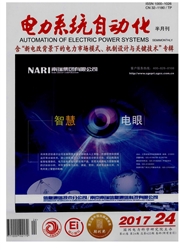

 中文摘要:
中文摘要:
稳态情况下,一般认为三次谐波具有零序分量特征,无法耦合至主变压器三角形侧设备,但经现场试验所得结论可知,和应涌流造成的不平衡三次谐波却可以流入主变压器低压侧,并与低压侧电容器组构成回路,有可能使电容器及避雷器损坏。系统稳态运行时,三次谐波仅仅存在零序分量;而和应涌流中的三次谐波电压、电流并不完全对称,存在三次谐波的正、负、零序分量,故涌流时的三次谐波的正序、负序分量能流出变压器的三角形侧,流入电容器组和负荷。同时,如果并联电容器组的电抗率为6%,则存在三次谐波串联谐振点,这是导致三次谐波进一步放大的原因。文中通过理论及仿真分析,论述了上述观点的正确性,并通过计算,设计出一种配置混合串联电抗器的并联电容器组。动模试验证明,配置混合串联电抗器的并联电容器组可以大大抑制系统侧及电容器支路中的三次及五次谐波,较配置统一串联电抗器的并联电容器组具有较大优势。
 英文摘要:
英文摘要:
Under the steady state condition,the third harmonic is in general thought to have the same features as those of the zero-sequence component,which cannot be coupled to the delta-side device of the transformer.However,field test results show that the unbalanced third harmonic caused by the sympathetic inrush can flow into the low-voltage side of the transformer.Hence,the third harmonic will form a loop with the capacitor on the low voltage side and may damage the capacitor and arrester.There is only zero-sequence component in the third harmonic under the steady state condition.On the other hand, the third harmonic voltage and current caused by the sympathetic inrush is not completely symmetric. Consequently,there are positive-sequence, negative-sequence and zero-sequence components. The positive-sequence and negative-sequence components in the sympathetic inrush would flow through the delta-side of the transformer and into the capacitor and load.Meanwhile,if the reactance ratio of the parallel capacitor bank is 6%,there will be a series resonance point of the third harmonic,which is the reason for further amplification of the third harmonic.With theoretical analysis and simulation study,the above point of view is validated.Besides,a parallel capacitor bank with a mixed series reactor is designed.The dynamic simulation test shows that the parallel capacitor bank with a mixed series reactor is able to effectively suppress the third and the fifth harmonics,which is much better than the parallel capacitor bank with unified series reactance.
 同期刊论文项目
同期刊论文项目
 同项目期刊论文
同项目期刊论文
 期刊信息
期刊信息
